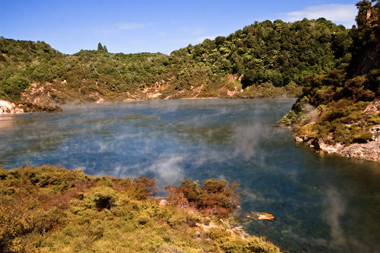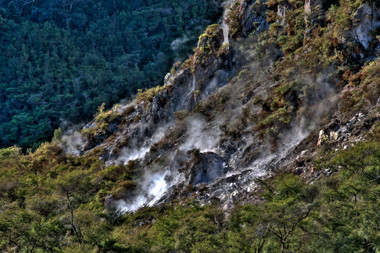 Geothermal vegetation at Waimangu. Photo: Chris Bycroft.Geothermal energy is derived from the Earth’s internal heat. Where it comes to the Earth’s surface it forms a range of geothermal features such as hot springs, lakes, fumaroles, geysers, heated soils, and hot streams.
Geothermal vegetation at Waimangu. Photo: Chris Bycroft.Geothermal energy is derived from the Earth’s internal heat. Where it comes to the Earth’s surface it forms a range of geothermal features such as hot springs, lakes, fumaroles, geysers, heated soils, and hot streams.
In New Zealand, geothermal vegetation has been identified as an ecosystem of historically limited extent, and naturally rare, even in pre-human landscapes (MfE and DOC 2007). The best definition for geothermal vegetation is that of Merrett and Clarkson (1999): “Geothermally influenced terrestrial and emergent wetland vegetation are plant communities that have compositional, structural, and/or growth rate characteristics determined by current and former inputs of geothermally-derived energy (heat) or materials (solid, fluid or gas).”
More information on geothermal processes in New Zealand can be found at the website of the NZ Geothermal Association.
- Distribution of geothermal vegetation
- Plants of geothermal habitats
- Types of geothermal vegetation
- Threats to geothermal vegetation
 Geothermal vegetation at Mangakakaramea (Rainbow Mountain). Photo: Chris Bycroft.For more information see*
Geothermal vegetation at Mangakakaramea (Rainbow Mountain). Photo: Chris Bycroft.For more information see*
- Geothermal vegetation dynamics by Bruce Burns and John Leathwick (1995). Part 1: Map of Geothermal Vegetation of the Te Kopia Scenic Reserve. Part 2: Plant species organisation along major environmental gradients. Science for Conservation 18. Department of Conservation, Wellington. 26pp
- Geothermal (Landcare Research)
- Given, D.R. 1980. Vegetation on heated soils at Karapiti, central North Island, New Zealand and its relation to ground temperature. New Zealand Journal of Botany 18: 1-13.
- Given D.R. 1995: Geothermal Vegetation - an assessment of botanical values of selected geothermal sites in the Taupo Volcanic Zone. David Given and Associates, Christchurch.
- Merrett M.F. Clarkson B.R. 1999: Definition, description and illustrations of geothermally influenced terrestrial and emergent wetland vegetation. Landcare Research Contract Report: LC9900/022.
- MfE and DOC 2007: Protecting our Places. Information about the statement of natural priorities for protecting rare and threatened biodiversity on private land. Ministry for the Environment and Department of Conservation, Wellington. 51 pp.
*The Network is not responsible for the content of external internet sites
